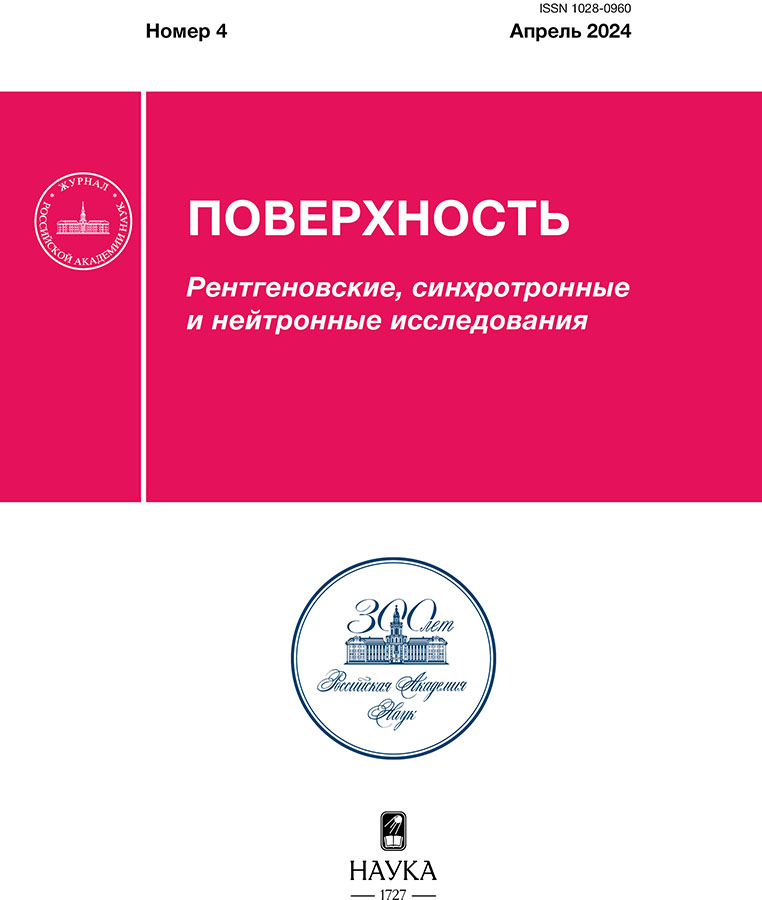Modeling of silicon irradiation with C60 ions and the role of the interaction potential
- Autores: Karasev K.P.1,2, Strizhkin D.A.2, Titov A.I.2, Karaseov P.A.2
-
Afiliações:
- Alferov University
- Peter the Great Saint-Petersburg Polytechnic university
- Edição: Nº 4 (2024)
- Páginas: 68-74
- Seção: Articles
- URL: https://rjeid.com/1028-0960/article/view/664659
- DOI: https://doi.org/10.31857/S1028096024040099
- EDN: https://elibrary.ru/GITLCO
- ID: 664659
Citar
Texto integral
Resumo
Molecular dynamic simulation was used to study the processes of impact of 2–14 keV C60 molecular ions on the Si(100) surface at temperatures of 0–1000 K. Tersoff–ZBL and Airebo interaction potentials were used and the electronic energy loss of fast particles was taken into account. It is shown that when simulating single impact events, the target temperature does not affect the development of the displacement cascade, but affects its thermalization and the formation of the crater on the surface. As the energy increases, the carbon penetration depth, the size of the formed crater and the rim increase. The sputtering coefficient of silicon atoms in this case increases linearly with energy, and in the case of carbon atoms it reaches a steady-state value at 10 keV. Using the Tersoff potential gives a larger number of atomized carbon atoms for single impact events compared to Airebo potential. During cumulative events, the formation of an etch pit is observed at the initial stage, followed by the carbon film growth. In contrast to single events, the use of the Airebo potential in the case of cumulative ion accumulation gives a higher sputtering coefficient than the Tersoff potential. The formation of carbide bonds in the crystal and an increase in their concentration with ion fluence slightly reduces the number of sputtered particles. Therefore, for correct comparison of simulation results with experiment, it is not enough to use the results of the analysis of single impact event. It is necessary to perform the simulation of the cumulative fluence accumulation.
Texto integral
Sobre autores
K. Karasev
Alferov University; Peter the Great Saint-Petersburg Polytechnic university
Autor responsável pela correspondência
Email: kir.karasyov2017@yandex.ru
Rússia, 195251, Saint-Petersburg; 195251, Saint-Petersburg
D. Strizhkin
Peter the Great Saint-Petersburg Polytechnic university
Email: kir.karasyov2017@yandex.ru
Rússia, 195251, Saint-Petersburg
A. Titov
Peter the Great Saint-Petersburg Polytechnic university
Email: kir.karasyov2017@yandex.ru
Rússia, 195251, Saint-Petersburg
P. Karaseov
Peter the Great Saint-Petersburg Polytechnic university
Email: platon.karaseov@spbstu.ru
Rússia, 195251, Saint-Petersburg
Bibliografia
- Аброян И.А., Андронов А.Н., Титов А.И. Физические основы электронной и ионной технологии. М.: Высшая школа, 1984. 135 с.
- Zhang L.D.J., Zhang X., Wang H., Li H., Li Y., Bu D. // J. Phys. D. 2021. V. 54. P. 333001.
- Redinger A., Hansen H., Linke U., Rosandi Y., Urbas-sek H., Michely T. // Phys. Rev. Lett. 2006. V. 96. P. 106103. https://www.doi.org/10.1103/PhysRevLett.96.106103
- Ieshkin A., Kireev D., Ozerova K., Senatulin B. // Mat. Lett. 2020. V. 272. P. 127829. https://www.doi.org/10.1016/j.matlet.2020.127829
- Insepov Z., Hassanein A., Norem J., Swenson D.R. // Nucl. Instrum. Methods Phys. Res. B. 2007. V. 261. P. 664. https://www.doi.org/10.1016/j.nimb.2007.04.134
- Kozole J., Winograd N. // Surface Analysis and Techniques in Biology / Ed. Smentkowski V.S., Springer Switzerland, 2014. P. 71. https://www.doi.org/10.1007/978-3-319-01360-2_4
- Mahoney C.M. Cluster Secondary Ion Mass Spectrometry: Principles and Applications. John Wiley & Sons, 2013.
- Delcorte A., Garrison B.J. // J. Phys. Chem. C. 2007. V. 111. P. 15312. https://www.doi.org/10.1021/jp074536j
- Khadem M., Pukha V.E., Penkov O.V., Khodos I.I., Belmesov A.A., Nechaev G.V., Kabachkov E.N., Karaseov P.A., Kim D.-E. // Surf. Coat. Technol. 2021. V. 424. P. 127670. https://www.doi.org/10.1016/j.surfcoat.2021.127670.
- Penkov O.V., Pukha V.E., Starikova S.L., Khadem M., Starikov V.V., Maleev M. V., Kim D.-E. // Biomaterials. 2016. V. 102. P. 130. https://www.doi.org/10.1016/j.biomaterials.2016.06.029
- Pukha V.E., Glukhov A.A., Belmesov A.A., Kabachkov E.N., Khodos I.I., Khadem M., Kim D.-E., Karaseov P.A. // Vacuum. 2023. V. 218. P. 112643. https://www.doi.org/10.1016/j.vacuum.2023.112643
- Pukha V., Popova J., Khadem M., Dae-Eun Kim, Kho-dos I., Shakhmin A., Mishin M., Krainov K., Titov A., Karaseov P. // International Youth Conference on Electronics, Telecommunications and Information Technologies. Springer Proceedings in Physics / Ed. Velichko E. et al. Cham: Springer, 2021. V. 255. P. 131. https://www.doi.org/10.1007/978-3-030-58868-7_15
- Maleyev M.V., Zubarev E.N., Pukha V.E., Drozdov A.N., Vus A.S., Devizenko A.Yu. // Metallofiz. Noveishie Tekhnol. 2015. V. 37. P. 91. https://www.doi.org/10.15407/mfint.37.06.0775
- Tersoff J. // Phys. Rev. B. 1988. V. 37. P. 6991. https://www.doi.org/10.1103/PhysRevB.37.6991
- Stuart S.J., Tutein A.B., Harrison J.A. // J. Chem. Phys. 2000. V. 112. P. 6472. https://www.doi.org/10.1063/1.481208
- Krantzman K.D., Kingsbury D.B., Garrison B.J. // Appl. Surf. Sci. 2006. V. 252. P. 6463. https://www.doi.org/10.1016/j.apsusc.2006.02.276
- Krantzman K.D., Garrison B.J. // Surf. Interface Anal. 2011. V. 43. P. 123. https://www.doi.org/10.1002/sia.3438
- Krantzman K.D., Wucher A. // J. Phys. Chem. C. 2010. V. 114. P. 5480. https://www.doi.org/10.1021/jp906050f
- Карасев К.П., Стрижкин Д.А., Титов А.И., Кара- сев П.А. // Поверхность. Рентген., синхротр. и нейтрон. исслед. 2023. № 1. P. 74.
- Thompson A.P., Aktulga H.M., Berger R., Bolintinea-nu D.S., Brown W.M., Crozier P.S., in't Veld P.J., Kohlmeyer A., Moore S.G., Nguyen T.D., Shan R., Stevens M.J., Tranchida J., Trott C., Plimpton S.J. // Comp. Phys. Commun. 2022. V. 271. P. 10817. https://www.doi.org/10.1016/j.cpc.2021.108171
- Ziegler J.F., Biersack J.P. The Stopping and Range of Ions in Matter // Treatise on Heavy-Ion Science / Ed. Bromley D.A. Boston: Springer, 1985. P. 93. https://www.doi.org/10.1007/978-1-4615-8103-1_3
- Karasev K., Strizhkin D., Karaseov P. // IEEE Xplore Proceed. of the 2022 Int. Conf. on Electrical Engineering and Photonics, EExPolytech 2022. P. 242. https://www.doi.org/10.1109/EExPolytech56308. 2022.9950888
- Berendsen H.J.C., Postma J.P.M., van Gunsteren W.F., DiNola A., Haak J.R. // J. Chem. Phys. 1984. V. 81. P. 3684. https://www.doi.org/10.1063/1.448118
- Krantzman K.D., Garrison B.J. // Nucl. Instrum. Methods Phys. Res. B. 2009. V. 267. P. 652. https://www.doi.org/10.1016/j.nimb.2008.11.055
- Бериш Р. Распыление твердых тел ионной бомбардировкой. М.: Мир, 1984. 336 с.
Arquivos suplementares















